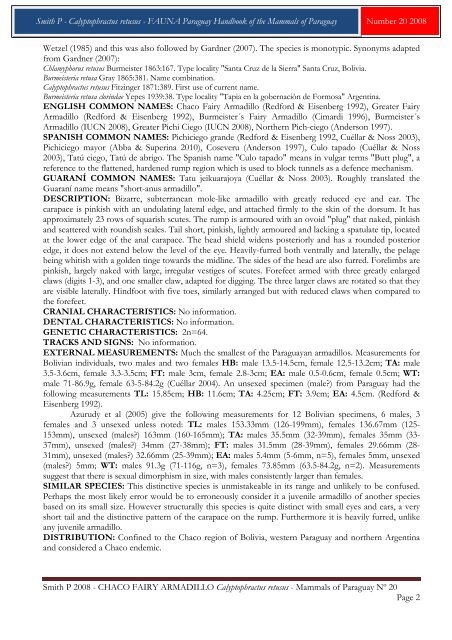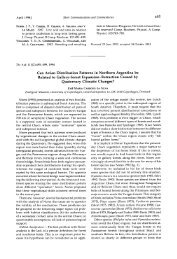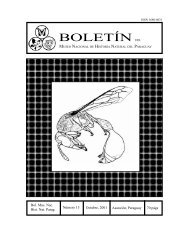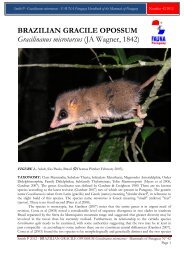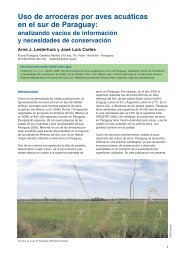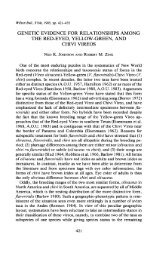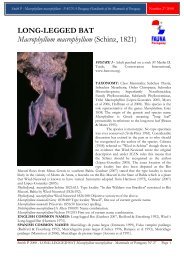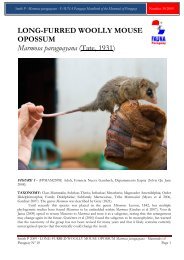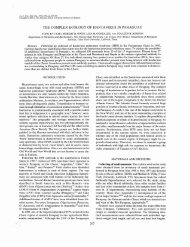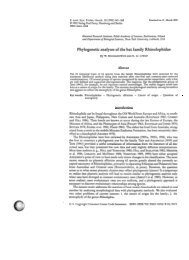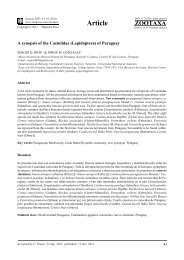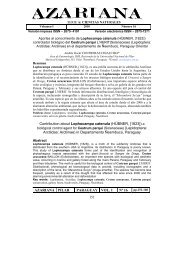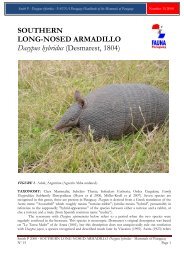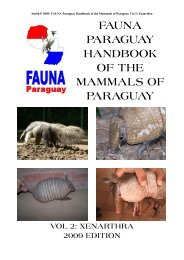CHACO FAIRY ARMADILLO Calyptophractus ... - FAUNA Paraguay
CHACO FAIRY ARMADILLO Calyptophractus ... - FAUNA Paraguay
CHACO FAIRY ARMADILLO Calyptophractus ... - FAUNA Paraguay
Create successful ePaper yourself
Turn your PDF publications into a flip-book with our unique Google optimized e-Paper software.
Smith P - <strong>Calyptophractus</strong> retusus - <strong>FAUNA</strong> <strong>Paraguay</strong> Handbook of the Mammals of <strong>Paraguay</strong> Number 20 2008<br />
Wetzel (1985) and this was also followed by Gardner (2007). The species is monotypic. Synonyms adapted<br />
from Gardner (2007):<br />
Chlamyphorus retusus Burmeister 1863:167. Type locality "Santa Cruz de la Sierra" Santa Cruz, Bolivia.<br />
Burmeisteria retusa Gray 1865:381. Name combination.<br />
<strong>Calyptophractus</strong> retusus Fitzinger 1871:389. First use of current name.<br />
Burmeisteria retusa clorindae Yepes 1939:38. Type locality "Tapia en la gobernaciòn de Formosa" Argentina.<br />
ENGLISH COMMON NAMES: Chaco Fairy Armadillo (Redford & Eisenberg 1992), Greater Fairy<br />
Armadillo (Redford & Eisenberg 1992), Burmeister´s Fairy Armadillo (Cimardi 1996), Burmeister´s<br />
Armadillo (IUCN 2008), Greater Pichi Ciego (IUCN 2008), Northern Pich-ciego (Anderson 1997).<br />
SPANISH COMMON NAMES: Pichiciego grande (Redford & Eisenberg 1992, Cuéllar & Noss 2003),<br />
Pichiciego mayor (Abba & Superina 2010), Coseveru (Anderson 1997), Culo tapado (Cuéllar & Noss<br />
2003), Tatú ciego, Tatú de abrigo. The Spanish name "Culo tapado" means in vulgar terms "Butt plug", a<br />
reference to the flattened, hardened rump region which is used to block tunnels as a defence mechanism.<br />
GUARANÍ COMMON NAMES: Tatu jeikuarajoya (Cuéllar & Noss 2003). Roughly translated the<br />
Guaraní name means "short-anus armadillo".<br />
DESCRIPTION: Bizarre, subterranean mole-like armadillo with greatly reduced eye and ear. The<br />
carapace is pinkish with an undulating lateral edge, and attached firmly to the skin of the dorsum. It has<br />
approximately 23 rows of squarish scutes. The rump is armoured with an ovoid "plug" that naked, pinkish<br />
and scattered with roundish scales. Tail short, pinkish, lightly armoured and lacking a spatulate tip, located<br />
at the lower edge of the anal carapace. The head shield widens posteriorly and has a rounded posterior<br />
edge, it does not extend below the level of the eye. Heavily-furred both ventrally and laterally, the pelage<br />
being whitish with a golden tinge towards the midline. The sides of the head are also furred. Forelimbs are<br />
pinkish, largely naked with large, irregular vestiges of scutes. Forefeet armed with three greatly enlarged<br />
claws (digits 1-3), and one smaller claw, adapted for digging. The three larger claws are rotated so that they<br />
are visible laterally. Hindfoot with five toes, similarly arranged but with reduced claws when compared to<br />
the forefeet.<br />
CRANIAL CHARACTERISTICS: No information.<br />
DENTAL CHARACTERISTICS: No information.<br />
GENETIC CHARACTERISTICS: 2n=64.<br />
TRACKS AND SIGNS: No information.<br />
EXTERNAL MEASUREMENTS: Much the smallest of the <strong>Paraguay</strong>an armadillos. Measurements for<br />
Bolivian individuals, two males and two females HB: male 13.5-14.5cm, female 12.5-13.2cm; TA: male<br />
3.5-3.6cm, female 3.3-3.5cm; FT: male 3cm, female 2.8-3cm; EA: male 0.5-0.6cm, female 0.5cm; WT:<br />
male 71-86.9g, female 63-5-84.2g (Cuéllar 2004). An unsexed specimen (male?) from <strong>Paraguay</strong> had the<br />
following measurements TL: 15.85cm; HB: 11.6cm; TA: 4.25cm; FT: 3.9cm; EA: 4.5cm. (Redford &<br />
Eisenberg 1992).<br />
Azurudy et al (2005) give the following measurements for 12 Bolivian specimens, 6 males, 3<br />
females and 3 unsexed unless noted: TL: males 153.33mm (126-199mm), females 136.67mm (125-<br />
153mm), unsexed (males?) 163mm (160-165mm); TA: males 35.5mm (32-39mm), females 35mm (33-<br />
37mm), unsexed (males?) 34mm (27-38mm); FT: males 31.5mm (28-39mm), females 29.66mm (28-<br />
31mm), unsexed (males?) 32.66mm (25-39mm); EA: males 5.4mm (5-6mm, n=5), females 5mm, unsexed<br />
(males?) 5mm; WT: males 91.3g (71-116g, n=3), females 73.85mm (63.5-84.2g, n=2). Measurements<br />
suggest that there is sexual dimorphism in size, with males consistently larger than females.<br />
SIMILAR SPECIES: This distinctive species is unmistakeable in its range and unlikely to be confused.<br />
Perhaps the most likely error would be to erroneously consider it a juvenile armadillo of another species<br />
based on its small size. However structurally this species is quite distinct with small eyes and ears, a very<br />
short tail and the distinctive pattern of the carapace on the rump. Furthermore it is heavily furred, unlike<br />
any juvenile armadillo.<br />
DISTRIBUTION: Confined to the Chaco region of Bolivia, western <strong>Paraguay</strong> and northern Argentina<br />
and considered a Chaco endemic.<br />
Smith P 2008 - <strong>CHACO</strong> <strong>FAIRY</strong> <strong>ARMADILLO</strong> <strong>Calyptophractus</strong> retusus - Mammals of <strong>Paraguay</strong> Nº 20<br />
Page 2


